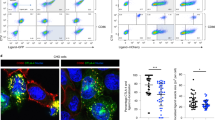Abstract
The CD4 glycoprotein is expressed on T-helper and cytotoxic lymphocytes which are restricted to class II major histocompatibility complex (MHC) antigens on target cells1–5. Antibody inhibition studies imply that CD4 acts to increase the avidity of effector-target cell interactions6–8. These observations have led to the speculation that CD4 binds to a monomorphic class II antigen determinant, thereby augmenting low affinity T-cell receptorantigen interactions9–11. However, no direct evidence has been presented indicating that CD4 and class II molecules interact. To address this issue, we have used a vector derived from simian virus 40 (SV40)12 to express a complementary DNA (cDNA) encoding the human CD4 glycoprotein13. When CV1 cells expressing large amounts of the CD4 protein at the cell surface are incubated with human B cells bearing MHC-encoded class II molecules, they are bound tightly to the infected monolayer, whereas mutant B cells which lack class II molecules fail to bind. Furthermore, the binding reaction is specifically inhibited by anti-class II and anti-CD4 antibodies. Thus, the CD4 protein, even in the absence of T-cell receptor-antigen interactions, can interact directly with class II antigens to function as a cell surface adhesion molecule.
This is a preview of subscription content, access via your institution
Access options
Subscribe to this journal
Receive 51 print issues and online access
$199.00 per year
only $3.90 per issue
Buy this article
- Purchase on Springer Link
- Instant access to full article PDF
Prices may be subject to local taxes which are calculated during checkout
Similar content being viewed by others
References
1. Reinherz, E. L. & Schlossman, S. F. Cell 19, 821-827 (1980). 2. Engleman, E. G., Benike, C. J., Grumet, F. C. & Evans, R. L. /. Immun. 127,2124-2129 (1981). 3. Biddison, W., Rao, P., Talle, M. A., Goldstein, G. & Shaw, S. /. exp. Med. 156, 1065-1076 (1982). 4. Krensky, A. M., Reiss, C. S., Mier, J. W., Strominger, J. L. & Burakoff, S. J. Proc. natn. Acad. Sci. USA 79, 2365-2369 (1982). 5. Meuer, S. C., Schlossman, S. F. & Reinherz, E. Proc. natn. Acad. Scl USA 79, 4395-4399 (1982). 6. Wilde, D. B., Marrack, P., Kappler, J., Dialynas, D. P. & Fitch, F. W., J. Immun. 131, 2178-2183 (1983). 7. Rogozinski, L., et al. J. Immun. 132, 735-739 (1984). 8. Swain, S. L., Dialynas, D., Fitch, F. W., & English, M. J. Immun. 132, 118-123 (1984). 9. Marrack, P., et al. J. exp. Med. 158, 1077-1092 (1983). 10. Greenstein, J. L., Kappler, J., Marrack, P. and Burakoff, S. J. J. exp. Med. 159, 1213-1224 (1984). 11. Greenstein, J. L., Malissen, B. & Burakoff, S. J. J. exp. Med. 162, 369-374 (1985). 12. Gething, M. J. & Sambrook, J. Nature 293, 620-625 (1981). 13. Maddon, P. J., et al. Cell 42, 93-104 (1985). 14. Pipas, J. M., Adler, S. P., Peden, K. W. C. & Nathans, D. Cold Spring Harb. Symp. quant. Bio/. 44, 285-291 (1980). 15. McCutchan, J. H. & Pagano, J. S. J. natn. Cancer Inst. 41, 351-357 (1969). 16. Luthman, H. & Magnusson, G. Nucleic Acids Res. 11, 1295-1308 (1983). 17. Doyle, C., Roth, M. G., Sambrook, J. & Gething, M. J. /. Cell Biol. 100, 704-714 (1985). 18. Accolla, R. S. / exp. Med. 157, 1053-1058 (1983). 19. Gladstone, P. & Pious, D. Nature 271, 459-461. 20. Lisowska-Grospierre, B., et al. J. din. Invest. 76, 381-385 (1985). 21. De Preval, C., & Mach, B. Immunogenetics 17, 133-140 (1983). 22. Gorga, J. C., Horejsi, V., Johnson, D. R., Raghupathy, R. & Strominger, J. L. /. biol. Chem. (in the press). 23. Gorga, J. C., Knudson, P. J., Foran, J. A., Strominger, J. L. & Burakoff, S. J. cell. Immun. 103, 160-173 (1986). 24. Watson, A. J., DeMars, R., Trowbridge, I. S. & Bach, F. H. Nature 304, 358-361 (1983). 25. Laemmli, U. K. Nature 227, 680-685 (1970).
Author information
Authors and Affiliations
Rights and permissions
About this article
Cite this article
Doyle, C., Strominger, J. Interaction between CD4 and class II MHC molecules mediates cell adhesion. Nature 330, 256–259 (1987). https://doi.org/10.1038/330256a0
Received:
Accepted:
Issue Date:
DOI: https://doi.org/10.1038/330256a0
This article is cited by
-
Soluble CD4 effectively prevents excessive TLR activation of resident macrophages in the onset of sepsis
Signal Transduction and Targeted Therapy (2023)
-
Reversal of the T cell immune system reveals the molecular basis for T cell lineage fate determination in the thymus
Nature Immunology (2022)
-
In Vitro Anti-Inflammatory Activity of Three Peptides Derived from the Byproduct of Rice Processing
Plant Foods for Human Nutrition (2022)
-
Antigen presentation by dendritic cells and their instruction of CD4+ T helper cell responses
Cellular & Molecular Immunology (2020)
-
Genome wide association and gene enrichment analysis reveal membrane anchoring and structural proteins associated with meat quality in beef
BMC Genomics (2019)
Comments
By submitting a comment you agree to abide by our Terms and Community Guidelines. If you find something abusive or that does not comply with our terms or guidelines please flag it as inappropriate.



